When we think of polar bears we think of icebergs, Alaska, the North Pole and because of environmental changes and diminishing ice floes we are also forced to think endangered species. When we think of the Polar Bears of Martha's Vineyard we think of tradition, acceptance, friendship, and now transition. Both groups of Vineyard and Arctic bears have more in common than you might realize.
For the past 62 years, the Polar Bears of Martha's Vineyard have staked out what they see as hallowed ground on the beach. In the mid-forties they swam in the waters between the Island Queen dock and the Steamship Authority and now between two imposing jetties on town beach, lovingly branded in the late fifties as the Inkwell. Some say the Inkwell was named by black identity-conscious youth; others say it was named for black writers such as Langston Hughes, Conte Cullen and others who visited Dorothy West regularly and met on the beach to engage in literary dialogue during that period.
Olga Coleman, the oldest active member of the Polar Bears, is unsure, but said she first heard the name 20 to 30 years ago. Today, most people refer to the beach as the Inkwell, and according to Judge Ed Redd, "for many African Americans it is a source of pride and a term of endearment."
To meet the Polar Bears is to encounter a windfall of sincerity, buoyant hospitality and plain old fun. In most cases such encounters are rare on a beach, but not in Oak Bluffs. As I listened to some of the oldest members share their history and looked at their photos and memorabilia I felt privileged to learn of this great informal institution that has survived for over 60 years without a constitution, bylaws, officers or any formal organizational structure other than the imperative of caring friendships.
Olga Coleman has been a member of the Polar Bears for 44 years, and has the distinction of being one of its original members. She stayed at Daisy Payne's house at 4 Warwick avenue, which still stands. There was no electricity, no indoor toilets, only chamber pots and an outhouse. Water was supplied using a pump. This was all new and somewhat shocking to a girl from Boston.
While in Oak Bluffs, Olga and her grandmother stopped at Myrtle O'Brien's guest house; Myrtle was an early African American innkeeper from Novia Scotia. There were nine others at the guest house who Olga learned were members of the Polar Bear Club: Lil'King, Thelma Suarez, Tony Suarez, Stanley Maynard, Evelyn Tyner, Norvey Wells, Frankie Townes, Gus Billips, and Gertrude Smith.
Olga liked the Vineyard from the first moment she arrived, so two or three years later she returned. This time she rented a room at Myrtle's. "Mrs. O'Brien didn't take children, but she allowed my daughter Linda to stay at the guest house," she recalled. Linda later swam with the Polar Bears. Mrs. O'Brien's guest house was at 222 South Circuit avenue, now the Tivoli Inn. Olga recalls that Myrtle O'Brien was "very short and very sweet," and somewhat of a health enthusiast who "believed that an early morning swim was not only invigorating, but healthy." She insisted that all of her inn guests accompany her to the sea at 7:30 in the morning for this ritual swim in the waters between the Island Queen and the Steamship Authority. That summer Olga happily began swimming with the Polar Bears. Now 79, she has not missed a summer since she was 17.
Olga recalls after the swim they would go back to Mrs. O'Brien's Inn where they sat in their swimsuits around her big black wood stove to dry off and drink coffee and eat day-old doughnuts. Coffee was served in milk-colored glass mugs which Mrs. O'Brien sold for 50 cents. The sugar was rationed. Each Polar Bear's name was painted on the mug with red fingernail polish. Today, Olga cherishes her mug and that of her partner, Stanley Maynard who died two years ago. Olga remembers the move to town beach. As the beach became rockier, the Polar Bears moved down the beach, past the segregated Pay Beach until they ended up at town beach, where they are today. Each summer the Polar Bears attracted new members.
All Polar Bears are not the same. There are three types of Bears that meet at 7:30 in the morning. There are the swimming bears, the nonswimming bears or bear-watchers and talkers, and the exercise bears, started by Ruth Bonaparte. They form a friendship circle in the water to work out. All are swimmingly friendly, cordial, very smart, and consider themselves totally nonelitist. Though many are accomplished there are no pedigree discussions here. There are Bear artists, physicians, lawyers, judges, corporate types, entrepreneurs, teachers, Ph.D's., writers, college professors, engineers, scientist, secretaries, former postal workers and media types. Their relationship is not about who they are, but what they do. They come to relax, reflect and renew. This is the old Martha's Vineyard in case you thought it no longer existed and they take their history and legacy seriously. As Bear Eleanor Hughes said, "We have our own chamber of commerce. If you want to know what's going on socially, where to eat, shop, find entertainment, or meet new people - come here. We are comrades and friends and everyone is welcome."
Evelyn Tyner, now 90, was an original Polar Bear. Her two daughters, Betsy Stewart and Leona Martin, carry on her legacy now that she no longer swims. Leona became a bear in the 1970s after seeing women aged 95 and 100 getting in the water. "I decided if they could do it, I could too," she said.
The Polar Bears begin their season every July Fourth with a prayer for continued friendship, for friends who are infirm, deceased, or need a special thought. Evelyn Tyner said the prayer for years. Now her daughter Betsy Stewart, a minister, prays. After prayer, they sing the 1985 musical hit made famous by Dionne Warwick, That's What Friends Are For. They have two mottos: "You have to spread your wings in order to find out how high you can fly," and "I am the source of my joy and infinite possibilities." Perhaps it is this strong belief system underpinning a "can-do" philosophy that has allowed the Polar Bears to survive all these years.
There have been as many as 100 people on the beach for the July 4 opening and Labor Day closing. Members pay five dollars annually. The money pays for breakfast, paper goods and get-well cards for ill members. An after-swim potluck breakfast is served on the beach every Monday. If there is a special celebration or birthday you can count on the Polar Bears to remember. They are also there to uplift those who may need a little tender loving care. Memorial and regular benches are purchased in recognition of family, friends, and deceased members. The first bench was dedicated to Lil' King, a highly revered Polar Bear from the original group. He blessed the waters before the Polar Bears entered precisely at 7:30 a.m. when he was alive. He was a sharp dresser, dapper in every respect.
In an atmosphere of collective joy, I joined the Polar Bears for a weekly Monday morning potluck and I thought I was back in Kentucky - three kinds of grits, three kinds of sausage, salmon, ginger pepperoni toast, kielbasa and cabbage, apple pandowdy, several breads and much more, all spread informally on a fold-up table covered with a bright tablecloth. The only thing missing (from the Kentucky point of view) was wild quail or pheasant in cream sauce warm off the hunting trail. As recorded by the late Eloise Allen of Philadelphia in Jill Nelson's book, Finding Martha's Vineyard, when she became a Polar Bear in the 1970s the small group of eight or nine met in each other's homes for coffee and doughnuts after the swim. As the group grew they moved to the bakery, and now with a membership of close to 100, though the daily beach-goers are considerably smaller, Monday breakfast on the beach draws lots of Bears and friends. "Bears love to eat," I was told.
As I observed and listened to the Bears who were there, many of whom I know well - Brenda Davenport, Delores and Matthew Goode, Dorothy Libran-Green, Larry Green, Gloria Manning, Liz Clanton, and her sister Johnny Marshall, and others I met for the first time such as Dorinda Davis, a third-year member, whose friend Meryth came for the first time and brought her grandmother's apple pandowdy recipe, and former Bear Dr. Bob Wilkinson, a great swimmer who characterized himself as "a staying on the fringe of the group guy," my view of who they were began to evolve.
I saw them in the context of shared history repeating itself over time. Then there was this connection to water and its relevance in the biblical sense of water as a cleanser, rejuvenator and healer in the African American baptismal experience. It surfaced as the tie that binds, underpinned by a conviction in the value of inclusiveness that expands the boundaries of diversity, transcends physical condition, color, race or belief - transforming the microcosmic reality of what America might be.
There was a profoundly serious side to this group that I came to understand as we laughed and talked about their presence on the Island in terms of their history, their triumphs, and yes even some scary moments experienced such as the time Gertrude Smith, a great swimmer at ninety who was floating on her back when caught in the current that took her far too close to tragedy. She was rescued by a boater. The Polar Bears have shared some sacred moments as well. The ashes of deceased family members have been broadcast over the waters beyond the Inkwell.
Phyllis DeChalus has been a Polar Bear since the early 1970s. Her granddaughter Tonya Adison, now 28, wrote on-line about her first encounter with the Polar Bears: "I was introduced to the Polar Bears at a very young age. I accompanied my grandmother on a walk along the bike path in Oak Bluffs. Upon our return, we took a refreshing swim in the waters of Nantucket Sound at town beach with a group of her friends. Did I mention it was about 7:30 in the morning? I am not a morning person, but as I look back, I would not change a thing. I was the Polar Bear mascot of sorts. They have continued to look after me and guide my course long after I have refrained from entering the cool waters with my grandma!" Tonya was nine at the time.
Then there is Gloria Wong, who lives in the Camp Ground. She is a fine swimmer possessing an awesome backstroke and dedicated member of the Polar Bears. She remembers riding her bike past the Pay Beach several times as a new arrival on the Island and watching the Polar Bears swim when she was invited to come down and join the group. That was in 1964 and she has been swimming daily from jetty to jetty every summer for 43 years. "It's about acceptance. It doesn't matter who you are," she said, a charming smile filling her face.
As I spoke with Gloria I noticed a man with a clam rake. When I asked him if he was going clamming, he introduced himself as Cappy Penderhughes. Cappy has been a Polar Bear for 15 years and each morning he goes down to the water's edge to rake away the stones and make an entry path for the swimmers.
Fran and Gus Gaskins are seasoned Bears as well. Both are New York Gold Medal winners in the Senior Games: Fran for the breast stroke and Gus for freestyle. They told their Bear story. Fran joined the Polar Bears in the late 1970s while teaching at Columbia University. She took a six-week vacation and also came on the weekends. Her husband, Gus, remembers that Labor Day in 1983 when he saw Gertrude Smith, an artist, [same person caught in the current] at the Tabernacle art show. She had entered the Cottager's children's art program projects in the show. Gertrude invited Gus to join the Polar Bears and he did. Though Gus is now legally blind, he walks down the steps to the beach and swims daily. It was Fran Gaskin's mother, Therese Farrelly Christian, 101 years old, who suggested the Monday breakfast on the beach to maintain interest and cameraderie. Mrs. Christian died last year.
Fran's grandchildren, Briana Gaskin, 14, Troy Ashley, 11, and Soleil Ocampo Gaskin, 8, all swim with the Polar Bears. One of the memorial benches facing the Inkwell is dedicated to Fran and Gus Gaskin's son, Conrad Anthony Gaskin 2nd (May 29, 1958 – August 11, 1995).
Artist Rose Treat, now 98, was asked to join the group while collecting seaweed at the Inkwell for her work. Her face fills with great emotion when sharing her experience that happened almost 30 years ago. "To think they would invite me, a Jewish woman, to join them. It was overwhelming. People from all walks of life are there and it doesn't matter." Today, the Polar Bears swim out past the shore line and gather seaweed for Rose since she can no longer come to the Inkwell. Though not an original member, Rose is the oldest living Polar Bear. She makes art from a unique seaweed which grows in only four places in the world; the Inkwell is one of those places.
Today the Polar Bears of Martha's Vineyard, like their namesake at the North Pole, face both an environmental challenge as well as continued survival as a group of aging Bears. Though no statistical data has been collected, some say the average age of the Polar Bears is 65. In the case of the arctic polar bears, temperatures are warming and their habitat is shrinking. They need more cold and more ice, food, and less global warming.
In the case of the Martha's Vineyard Polar Bears they have a beach erosion problem. Devastated by storms more and more sand is needed at the Inkwell. Each year the beach becomes smaller and smaller. There is little doubt that these Bears will survive the sand erosion problem. They will use their talents, resources and winning ways to ensure that the Army Corps of Engineers, state and local authorities intervene. But the Bears' aging problem may be far more threatening to the tradition. Judge Ed Redd and Andrea Taylor, both 25-year Polar Bears, are optimistic. Ed said: "There will be a natural transition. When I'm being wheeled out, my kids will come." Then in a more serious tone, he concluded, "People have to be concerned, but this beach and the Polar Bears are a source of pride and endearment. We will survive."
Andrea Taylor shares Ed's view. "It will continue," she said. "And let me tell you why. I brought my granddaughter down here last week without a bathing suit [she left it at home] and we walked in the water with her pretty dress on and she didn't want to get out."
Like many middle class African American institutions forged out of segregation and discrimination some may consider the Polar Bears to be a relic of the past. That is clearly not the view of anyone I spoke with. I would like to think that the saving grace will not be simply whether African Americans come, but whether the prevailing philosophy of the group that encourages all to come will resonate within the broader community.
As this remarkable group face their future they will call on resources that have shaped their past, as well as a different imagination to ensure their future. When I gaze upon this community where each is a poem in shades of bronze and gold and peach, as diverse as life itself reaching toward the inner soul of life's possibilities, my hope is renewed, my admiration overwhelming.

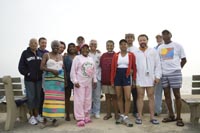

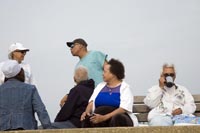
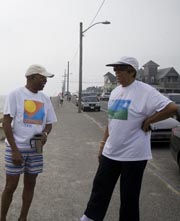
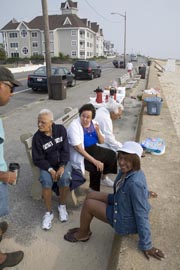

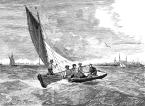



Comments (7)
Comments
Comment policy »